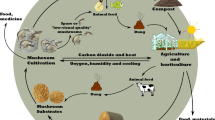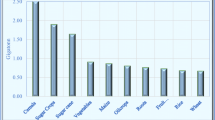Abstract
There is an increased interest in composting as an effective means of handling large amounts of organic wastes generated by oil palm industries in Malaysia. However, very few studies have been conducted to develop an effective composting process using the multi-enzymatic system. This study demonstrates an effective composting process of EFB (empty fruit bunch) with POME (palm oil mill effluent), using the optimized process parameters and compatible multi-enzymatic fungal system. A higher decrease (3 %) of organic matter was achieved in the fungal treated system, almost double that of the control (without inoculum). The lowest C/N ratio and soluble protein content recorded were about 17 and 128.82 g/kg, respectively. The maximum germination index obtained was 116 % at day 50 of treatment, which is considered high compared to the control (uninoculated). Furthermore, the maximum activity of ligninase enzyme was found to be 25.95 U/g and the highest cellulase activity was recorded at 0.975 U/g.






Similar content being viewed by others
References
MPOB (2006) Malaysian Palm Oil Board. http://www.mpob.gov.my. Accessed October 2006
Baharuddin AS, Kazunori N, Abd-Aziz S, Tabatabaei M, Rahman NA, Hassan MA, Wakisaka M, Sakai K, Shirai Y (2009) Characteristics and microbial succession in co-composting of oil palm empty fruit bunch and partially treated palm oil mill effluent. Open Biotechnol J 3:92–100
Abas R, Kamarudin MF, Nordin ABA, Simeh MA (2011) A study on the Malaysian oil palm biomass sector-supply and perception of palm oil millers. Oil Palm Ind Econ J 11(1):28–41
Igwe JC, Onyegbado CC (2007) A review of palm oil mill effluent (POME) water treatment. Glob J Environ Res 1(2):54–62
Thambirajah JJ, Zulkali MD, Hashim MA (1995) Microbiological and biochemical changes during the composting of oil palm empty fruit bunch; Effect of Nitrogen supplementation on the substrate. Biosci Technol 52:133–144
Franke M (1998) Kompostierung von Ernteabfällen in den Tropen am Beispiel von Ölpalme und Zuckerrohr. Verlag Ulrich Grauer, Stuttgart. ISBN 3-86786-207-7
Schuchardt F, Susilawati E, Guritno P (1999) Trials about composting of solid wastes from palm oil mills. In: Indonesia.-Proc. Intern. Conference ORBIT 99 on Biological Treatment of Waste and the Environment, 2–4 Sept 1999, Weimar, Germany, pp 155–164
Schuchardt F, Balcke S, Becker F, Guritno P, Herawan TE, Darnoko D (2000) Production of compost from EFB. In: Integrated management of palm oil mill solid wastes and effluents. Medan, 13–14 June 2000. Pusat Penelitian Kelapa Sawit, Medan, pp 4.1–4.25
Schuchardt F, Darnoko D, Guritno P (2002) Composting of empty oil palm fruit bunch (EFB) with simultaneous evapoaration of oil mill waste water (POME). In: 2002 International oil palm conference, Nusa Dua, Bali, Indonesia, 8–12 July 2002
Kabbashi NA, Alam MZ, Ainuddin M (2006) Bio-composting process development by SSF for utilization agro-industrial wastes. In: 3rd Kuala Lumpur international conference on biomedical engineering 2006 (Biomed 2006), IFMBE Proceedings, 11–14 Dec 2006, Kuala Lumpur, Malaysia
Yasmeen S, Sariah M, Ismail R, Rahmani M, Ali A (2008) Bio-efficiency of compost extracts on the wet rot incidence, morphologica and physiological growth of okra (Abelmoschus esculentus [(L) Moench]). Sci Hortic 117:9–14
Yahya A, Sye CP, Ishola TA, Suryanto H (2010) Effect of adding palm oil mill decanter cake slurry with regular turning. Bioresour Technol 101:8736–8741
Suhaimi M, Ong HK (2001) Composting empty fruit bunches of oil palm. FFTC Publication. Malaysian Agricultural Research and Development Institute, Malaysia, 1 Nov 2001
Hamdan AB, Tarmizi AM, Tayeb Mohd D (1998) Empty fruit bunch mulching and nitrogen fertilizer amendment: the resultant effect on oil palm performance and soil proper-ties. PORIM Bull Palm Oil Res Inst Malaysia 37:105–111
Unapumnuk K (1999) Solid waste management in palm oil mills: a case study in Thailand. Master’s Thesis, Asian Institute of Technology, Thailand
Mohammad N, Alam MZ, Kabbashi NA, Ahsan A (2012) Effective composting of oil palm industrial waste by filamentous fungi: a review. Resour Conserv Recycl 58:69–78
Molla AH, Fakhru’l-Razi A, Abd-Aziz S, Hanafi MM, Alam MZ (2001) In vitro compatibility evaluation of fungal mixed culture for bioconversion of domestic wastewater sludge. World J Microbiol Biotechnol 17:849–856
Alam MZ, Fakhru’l-Razi A, Molla AH (2003) Optimization of liquid state bioconversion process for microbial treatment of domestic wastewater sludge. J Environ Eng Sci 2:299–306
Mohammad N (2012) Development of effective composting process by fungal mixed culture using oil palm waste. Dissertation, International Islamic University Malaysia, Malaysia
Mohammad N, Alam MZ, Kabbashi NA (2011) Development of compatible fungal mixed culture for composting process. Afr J Biotechnol 10(81):18657–18665
Wong JWC, Mak KF, Chan NW, Lam A, Fang M, Zhou LX, Wu QT, Liao XD (2001) Co-composting of soybean residues and leaves in Hong Kong. Bioresour Technol 76(2):99–106
Navarro AF, Cegarra J, Roig A, Garcia D (1993) Relationships between organic matter and carbon contents of organic wastes. Bioresour Technol 44:203–207
Walkley SA, Black IA (1934) An experimentation of the Degtjareff method for determining soil organic matter and proposed modification of the chromic acids titration method. Soil Sci 37:29–38
Lowry OH, Rosebrough NJ, Farr AL, Randall RJ (1951) Protein measurement with the Folin Phenol Reagent. J Biol Chem 193:265–275
Tiquia S (2003) Evaluation of organic matter and nutrient composition of partially decomposed and composted spent pig litter. Environ Technol 24(1):97–107
Archibald FS (1992) A new assay for lignin-type peroxidases employing the dye azure B. Appl Environ Microbiol 58:3110–3116
Ghose TK (1987) Measurement of cellulase activities. Pure Appl Chem 59:257–268
Kausar H, Sariah M, Saud MH, Alam MZ, Ismail MR (2010) Development of compatible lignocellulolytic fungal consortium for rapid composting of rice straw. Int Biodeterior Biodegradation 64:594–600
Khan E, Khaodhir S, Ruangrote D (2009) Effects of moisture content and initial pH in composting process on heavy metal removal characteristics of grass clipping compost used for stormwater filtration. Bioresour Technol 100:4454–4461
McCartney D, Tingley J (1998) Development of a rapid method for compost materials. Compost Sci Util 6:14–25
Margesin R, Cimadom J, Schinner F (2006) Biological activity during composting of sewage sludge at low temperatures. Int Biodeterior Biodegradation 57:88–92
Betton CI (1992) Lubricants and their environmental impact. In: Mortier RM, Orszulik ST (eds) Chemistry and technology lubricants. Blackie Academic & Professional Press, pp 282–298
Molla AH (2002) Solid state bioconversion of domestic waste waster treatment plant sludge into compost by screened filamentous fungi. Faculty of Engineering, University Putra Malaysia, Malaysia
Turan NG (2008) The effects of natural zeolite on salinity level of poultry litter compost. Bioresour Technol 99:2097–2101
Lei F, VanderGheynst JS (2000) The effect of microbial inoculation and pH on microbial community structure changes during composting. Process Biochem 35:923–929
Charest MH, Beauchamp CJ (2002) Composting of deinking paper sludge with poultry manure at three nitrogen levels using mechanical turning: behavior of physicochemical parameters. Bioresource Technol 81:7
Fang M, Wong JWC, Ma KK, Wong MH (1999) Co-composting of sewage sludge and coal fly ash: nutrient transformations. Bioresour Technol 67(1):19–24
Fang M, Wong JWC, Li GX, Wong MH (1998) Changes in biological parameters during co-composting of sewages sludge and coal ash residues. Bioresource Technol 64:55–61
Sanchez-Monedero MA, Roig A, Paredes C, Bernal MP (2001) Nitrogen transformation during organic waste composting by the Rutgers system and its effects on pH, EC and maturity of the composting mixtures. Bioresour Technol 78:301–308
Morel JL, Cohn F, Germon JC, Godin P, Juste C (1985) Methods for the evaluation of the maturity of municipal refuse compost. In: Gasser JKR (ed) Composting of agricultural and other wastes. Elsevier Applied Science, New York, USA, pp 5672
Gao M, Liang F, Yu A, Li B, Yang L (2010) Evaluation of stability and maturity during forced-aeration composting of chicken manure and sawdust at different C/N ratios. Chemosphere 78:614–619
Molla AH, Fakhru’l-Razi A, Alam MZ (2004) Evaluation of solid-state bioconversion of domestic wastewater sludge as a promising environmental-friendly disposal technique. Water Res 38:4143–4152
Brouillette M, Trepanier L, Gallichand J, Beauchamp C (1996) Composting paper mill deinking sludge with forced aeration. Can Agric Eng 38(2):115
Campbell AG, Engebretson RR, Tripepi RR (1991) Composting a combined RMP/CMP pulp and paper sludge. Tappi J 74(9):183
Tiquia SM, Tam NFY (2000) Co-composting of spent pig litter and sludge with forced-aeration. Bioresour Technol 72:1–7
Michel FC, Forney LJ, Huang AJ, Drew S, Czuprenski M, Lindeneg JD, Reddy CA (1996) Effects of turning frequency, leaves to grass ratio and windrow vs pile configuration on composting of yard trimmings. Compost Sci Util 4:26–43
Cuevas VC (2000) Rapid composting technology in Philipines: its role in production of good organic fertilizers. Inst Biol Sci 1:5–10
Hirai MF, Chanyasak V, Kubota H (1983) A standard measurement for compost maturity. Biocycle 24:54–56
Heerden IV, Cronjé C, Swart SH, Kotzé JM (2002) Microbial, chemical and physical aspects of citrus waste composting. Bioresour Technol 81(1):71–76
Jimenez EI, Perez-Garcia V (1992) Composting of domestic refuse and sewage sludge. II. Evolution of carbon and some “humification” indexes. Resour Conserv Recycl 8:45–60
Mathur SP, Owen G, Dinel H, Schnitzer M (1993) Determination of compost biomaturity. I. Literature review. Biol Agric Hortic 10(2):65–85
Prado FC, Vandenberghe LPS, Soccol CR (2005) Relation between citric acid production by solid-state fermentation from cassava bagasse and respiration of Aspergillus niger LPB21 in semi-pilot scale. Brazilian Arch Biol Technol 48:29–36
Raghavarao KSMS, Ranganathan TV, Karanth NG (2003) Some engineering aspects of solid-state fermentation. Biochem Eng J 13:127–135
Zheng Z, Shetty K (1998) Cranberry processing waste for solid state fungal inoculant production. Process Biochem 33(3):323
Zucconi F, Pera A, Forte M, de Bertoldi M (1981) Evaluation of toxicity of immature compost. BioCycle 22(2):54–57
Zucconi F, Pera A, Forte M, de Bertoldi M (1981) Biological evaluation of compost maturity. BioCycle 22(4):27–29
Huang GF, Wong JWC, Wu QT, Nagar BB (2004) Effect of C/N on composting of pig manure with sawdust. Waste Manage (Oxford) 24:805–813
Molla AH, Fakhru’l-Razi A, Hanafi MM, Abd-Aziz S, Alam MZ (2002) Potential non-phytopathogenic filamentous fungi for bioconversion of domestic wastewater sludge. J Environ Sci Health Part A Toxic/Hazardous Subst Environ Eng A37(8):1495–1507
De Vleeschauwer D, Verdonck O, Van Assche P (1981) Phytotoxicity of refuse compost. Biocycle 1:44–46
Kirk PM, Cannon PF, Minter DW, Stalpers JA (2008) Dictionary of the fungi, 10th edn. CABI, Wallingford, p 505
Jodice R (1989) Chemical and biological parameters for evaluating compost for evaluating compost quality. In: Micheleall Adige E (ed) Instituto agrario provinciale. Proceedings of the COMPOST production and use, international symposium, pp 363–384
Xu H (1999) Studies on aerated static pile on sewage composting. M.Sc. Dissertation, Research Center for Eco-Environmental Sciences, Chinese Academy of Sciences, Beijing
Brown RM, Saxena IM (1996) Cellulose biosynthesis in higher plants. Trends Plant Sci 1(5):149–156
Lynch JM (1992) Substrate availability in the production of composts. In: Hoitink HAJ, Keener H (eds) Proceedings of the international composting research symposium, pp 24–35
Van Wyk JPH (2001) Sequential bioconversion of used paper to sugars by cellulases from Trichoderma reesei and Penicillium funiculosum. Environmentalist 21:211–220
Bari N (2009) Production of citric acid from renewable oil palm empty fruit bunches by solid state bioconversion using locally isolated Aspergillus niger. PhD Theis. Department of Biotechnology Engineering, Faculty of Engineering, International Islamic University Malaysia), Malaysia
Goyal S, Dhull SK, Kapoor KK (2005) Chemical and biological changes during composting of different organic wastes and assessment of compost maturity. Bioresour Technol 96(2005):1584–1591
Acknowledgments
The authors are grateful to the Research Management Center (RMC) by providing the financial support (Endowment Grant, type B: EDW10-110-0449) and the Department of Biotechnology Engineering, International Islamic University Malaysia (IIUM) for its lab facilities.
Author information
Authors and Affiliations
Corresponding author
Rights and permissions
About this article
Cite this article
Mohammad, N., Alam, M.Z. & Kabashi, N.A. Development of composting process of oil palm industrial wastes by multi-enzymatic fungal system. J Mater Cycles Waste Manag 15, 348–356 (2013). https://doi.org/10.1007/s10163-013-0125-x
Received:
Accepted:
Published:
Issue Date:
DOI: https://doi.org/10.1007/s10163-013-0125-x




